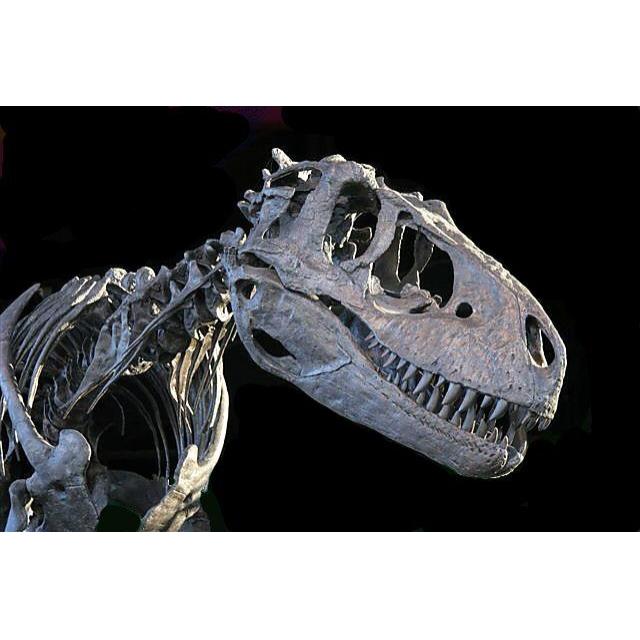Albertosaurus (/ælˌbɜrtɵˈsɔrəs/; meaning “Alberta lizard”) is a genus of tyrannosaurid theropod dinosaur that lived in western North America during the Late Cretaceous Period, about 70 million years ago. The type species, A. sarcophagus, was apparently restricted in range to the modern-day Canadian province of Alberta, after which the genus is named. Scientists disagree on the content of the genus, with some recognizing Gorgosaurus libratus as a second species.
As a tyrannosaurid, Albertosaurus was a bipedal predator with tiny, two-fingered hands and a massive head that had dozens of large, sharp teeth. It may have been at the top of the food chain in its local ecosystem. Although relatively large for a theropod, Albertosaurus was much smaller than its more famous relative Tyrannosaurus, probably weighing less than 2 metric tons.
Since the first discovery in 1884, fossils of more than 30 individuals have been recovered, providing scientists with a more detailed knowledge of Albertosaurus anatomy than is available for most other tyrannosaurids. The discovery of 26 individuals at one site provides evidence of pack behaviour and allows studies of ontogeny and population biology, which are impossible with lesser-known dinosaurs.
Albertosaurus was smaller than some other tyrannosaurids, such as Tarbosaurus and Tyrannosaurus. Typical Albertosaurus adults measured up to 9 metres (30 feet) long, while rare individuals of great age could grow to be over 10 metres (33 feet) long. Several independent mass estimates, obtained by different methods, suggest that an adult Albertosaurus weighed between 1.3 tonnes (1.4 short tons) and 1.7 tonnes (1.9 tons).
Albertosaurus shared a similar body appearance with all other tyrannosaurids. Typically for a theropod, Albertosaurus was bipedal and balanced the heavy head and torso with a long tail. However, tyrannosaurid forelimbs were extremely small for their body size and retained only two digits. The hind limbs were long and ended in a four-toed foot on which the first digit, called the hallux, was short and did not reach the ground. The third digit was longer than the rest. Albertosaurus may have been able to reach walking speeds of 14−21 kilometres per hour (8−13 miles per hour). At least for the younger individuals, a high running speed is plausible.
The massive skull of Albertosaurus, which was perched on a short, S-shaped neck, was approximately 1 metre (3.3 feet) long in the largest adults. Wide openings in the skull (fenestrae) reduced the weight of the head while also providing space for muscle attachment and sensory organs. Its long jaws contained, both sides combined, 58 or more banana-shaped teeth; larger tyrannosaurids possessed fewer teeth, Gorgosaurus at least sixty-two. Unlike most theropods, Albertosaurus and other tyrannosaurids were heterodont, with teeth of different forms depending on their position in the mouth. The premaxillary teeth at the tip of the upper jaw, four per side, were much smaller than the rest, more closely packed, and D-shaped in cross section. Like with Tyrannosaurus, the maxillary (cheek) teeth of Albertosaurus were adapted in general form to resist lateral forces exerted by a struggling prey. The bite force of Albertosaurus was less formidable, however, with the maximum force, by the hind teeth, reaching 3,413 Newtons. Above the eyes were short bony crests that may have been brightly coloured in life and used in courtship to attract a mate.
Reconstruction
William Abler observed in 2001 that Albertosaurus tooth serrations resemble a crack in the tooth ending in a round void called an ampulla. Tyrannosaurid teeth were used as holdfasts for pulling meat off a body, so when a tyrannosaur pulled back on a piece of meat, the tension could cause a purely crack-like serration to spread through the tooth. However, the presence of the ampulla distributed these forces over a larger surface area, and lessened the risk of damage to the tooth under strain. The presence of incisions ending in voids has parallels in human engineering. Guitar makers use incisions ending in voids to, as Abler describes, “impart alternating regions of flexibility and rigidity” to the wood they work with. The use of a drill to create an “ampulla” of sorts and prevent the propagation of cracks through material is also used to protect aircraft surfaces. Abler demonstrated that a plexiglass bar with incisions called “kerfs” and drilled holes was more than 25% stronger than one with only regularly placed incisions. Unlike tyrannosaurs, ancient predators like phytosaurs and Dimetrodon had no adaptations to prevent the crack-like serrations of their teeth from spreading when subjected to the forces of feeding.









